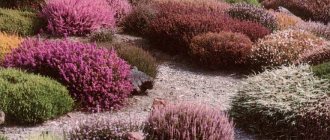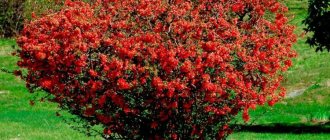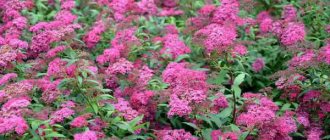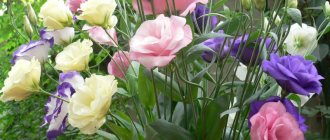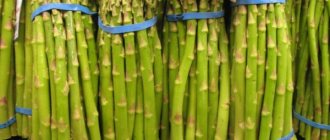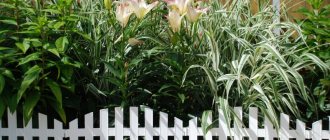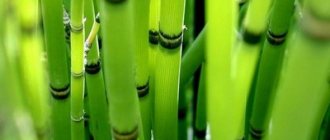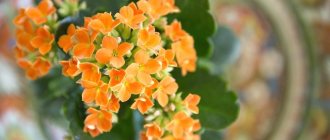Botanical description
Barberry bears fruit abundantly with large, often edible berries, which are used as food in many cuisines around the world. The elegant appearance of the ornamental plant is actively used in landscape design. Dwarf varieties of barberry are grown at home.
The plant does not require special care and attention, it has drought-resistant and frost-resistant qualities. It reproduces well by all popular gardening methods. It does not require constant fertilizing, rarely gets sick, and takes root well in any soil.
Gorgeous specimen with pinkish leaves
Barberry is called a candy bush at the suggestion of Soviet confectioners, who gave its name to their famous caramels. But if you look at the large, ripe and bright fruits of the plant, it’s really hard not to associate them with a sweet delicacy.
There are varieties with evergreen, partially deciduous and deciduous crowns. The leaves grow in bunches in regular order. Thin branches covered with thorns tend upward at an acute angle.
Depending on the type and variety, the shrub can reach a height of 30 cm to 3 m. The crown of the latter in adulthood acquires columnar, spherical or spreading outlines. The average age of an individual is 35-50 years.
Sharp spines and ripe fruits
Barberry blooms in late spring and early summer in a bright palette of shades: violet, purple, red, pink, yellow, white, green, variegated. Flowering lasts 2-3 weeks. Towards the beginning of autumn, oblong oval-shaped berries, red, black or burgundy, appear.
The fruits do not spoil on the branches for a long time, even in winter diluting the snow-white landscape with the rich colors of summer. Most barberry species are honey plants.
Fresh honey has a medium consistency, sweet taste and golden hue.
What barberry looks like and how it blooms: photos and descriptions of species and varieties
Most often used in landscaping:
The relatively large common barberry (B. vulgaris) and its purple-leaved form 'Atropurpurea'. The common species is also widely known as a fruit plant;
Thunberg's barberry (B. thunbergii) , which is propagated by many gardeners, has especially many decorative forms and varieties, differing in the color of the leaves and the size and shape of the crown;
Ottawa barberry (B. x ottawensis) , which is a hybrid of the first two species.
Bushes are undemanding to soil. They tolerate drought better than excess moisture. They can tolerate partial shade, although in the light they show their decorative qualities more fully. They propagate well from summer cuttings.
Due to their beauty, variety of shapes and colors, the plant can be used as a single planting of decorative barberry, in small groups or to create hedges. Most species combine well with other shrubs. Low-growing coniferous trees are the most common garden neighbor for barberry. The plant goes well with alpine hills, and also as a central shrub when decorating flower beds.
Growing barberry in the garden is not a hassle for its owner.
Any variety of barberry bush is incredibly attractive. Many gardeners are confused by the variety of species of this plant. But in order to make a choice, it is recommended to focus on the goal you are pursuing.
If you want a plant to please you with delicious berries, then these are the only varieties. If you want to decorate your garden, use decorative species. Further in the article we will talk about different varieties of barberries with photos and descriptions of the characteristics of each. We have already mentioned them above. Note that each species we present copes well with both tasks: it will decorate your garden and produce edible, tasty fruits.
Common barberry is one of the most commonly found plant species. Reaches a height of up to three meters. The leaves are elliptical in shape; on the inside they are gray-green in color, and on the front they are dark green. The bushes have shoots of a gray-brown color, with spines up to 2 cm. This species blooms for 3 weeks. The inflorescence has a racemose shape up to 6 cm, consists of fragrant flowers of a yellow hue. The fruits reach 1.5 cm in length and have a bright red hue.
Common barberry has quite a few subspecies:
Aureo-Marginata
Albo Variegata
Asperma
The last representative of the plant of this species has a fruit without a seed, which makes it easier to process.
Look what the species of common barberry look like in the photo.
The Thunberg variety can be considered a leader among ornamental barberries.
If we compare it with the previous type, its size is much smaller. An adult bush reaches a height of no more than 1 m. The branches of the bush spread in a horizontal direction. Depending on the variety, the young shoots of the plant can be bright red or even yellow, which later turn brown. The foliage is ovoid, slightly elongated, with an average length of no more than 3 cm.
In summer, the bush has a brightly saturated green color due to the color of the leaves; by autumn it turns bright red.
The color lasts no more than 2 weeks. During this period, the bush acquires a red-yellow hue. The flowers of the barberry bush of the Thunberg variety have a double color: the petals are yellow on the inside, and bright red on the outside. The ellipsoid fruits reach 1 cm in length, have a coral tint and ripen in early autumn. If they are not collected, they can survive on the branches until the first serious frost. Thunberg barberry, the care and cultivation of which does not require special knowledge or skills, will give a different, more aesthetic look to your garden plot. This species also has many hybrid varieties that are considered ornamental: multi-flowered, silver-edged, dark purple, etc.
Look what the Thunberg variety of barberries look like in the photo.
Ottawa variety is a shrub that combines the qualities of the first and second types.
This species is perfect for regions with fairly harsh winters. In terms of external characteristics, this plant is similar to Thunberg, but in an enlarged form. Its height reaches 2 m. But the leaves are closer in color and shape to the ordinary species. They have a pink-violet hue that turns almost black in the sun. On autumn days, when most of the colors in the garden have faded, the bush will become its most beautiful, as its leaves take on a crimson hue and stay on the branches for quite a long time.
Ottawa barberry, its types and varieties are presented in the photo:
Auricoma
Superba
Silver Miles
In addition to the listed varieties, all over the world you can find barberries of various decorative varieties, which differ in their color, height, and leaf shape.
To create alpine slides, dwarf varieties of barberry bushes are used:
Atropurpurea
Bagatelle
Cobolt
Look how effective this barberry looks - an ornamental shrub in the photo surrounded by stones:
Their height does not reach more than 50 cm, which is why these varieties are called dwarf.
Halo of growth
The plant is a typical inhabitant of almost the entire territory of the Northern Hemisphere, with the exception of permafrost latitudes. For decorative and cultural purposes, it is bred in Europe, the Far East, China, Japan, Central Asia, North America, the Caucasus, Persia, Siberia, and Crimea.
The shrub tolerates temperature changes typical of a temperate continental climate. Some varieties are insulated for the winter, others are quite frost-resistant. Heat is also not a big problem for barberry.
Luxurious palette of plant shades
Grows in any soil, even with a composition poor in nutrients. The small root system allows the tree to easily get along with other vegetation.
The main requirement for environmental conditions is the absence of stagnation of moisture in the roots and a sufficient amount of light.
Barberry tolerates drought much better than excess water. It is able to grow in the shade, but in this case the color of the foliage will not be bright and saturated. Fruiting will also not be abundant.
Planting common barberry
The time of planting barberryBarberry (from the Latin Berberis) is a large genus of shrubs, less often trees, of the family ... should be determined by temperature indicators. These are mainly the autumn months, before the onset of cold weather or in the second decade of spring. Barberry seedlingsBarberry (from the Latin Berberis) is a large genus of shrubs, less often trees, family ... it is preferable to plant in the evening.
Growing barberryBarberry (from the Latin Berberis) is a large genus of shrubs, less often trees, family ... will not be difficult, even a novice gardener can cope with the bush, the main thing is to follow some recommendations when planting the plant. In order for BarberryBarberry (from the Latin Berberis) - a large genus of shrubs, less often trees, family... to delight with bright colors, you should choose a well-lit, quiet place. The distance for planting barberry seedlingsBarberry (from the Latin Berberis) is a large genus of shrubs, less often trees, family... varies in steps from one and a half meters, if we are talking about a single planting, and not about the construction of a hedge.
Barberry bushesBarberry (from the Latin Berberis) is a large genus of shrubs, less often trees, of the family ... can be planted in both linear and checkerboard order, the plant will begin to grow in any case.
As for the suitable soil, it should be turf; ideally, chernozems are suitable, with low acidity (high soil acidity is eliminated by liming), and a high humus content. If the soil on your site is poor, enrich it artificially, add rotted manure and mineral fertilizers. Like any other ornamental plants, barberryBarberry (from the Latin Berberis) is a large genus of shrubs, less often trees, family ... needs light, both for the formation of fruits and to maintain the brightness of the bush.
The next step is drainage. BarberryBarberry (from the Latin Berberis) is a large genus of shrubs, less often trees, of the family... will not survive long-term stagnation of moisture in the soil, will not tolerate waterlogging and will simply rot.
Therefore, when planting barberry, it would not be superfluous to add sand into the hole, in the volume of a quarter of a bucket.
So, in a well-lit place, dig a planting hole about 40-50 cm deep and about 35-45 cm wide. Pour about 7-8 cm of river sand, add sawdust on top with a layer of 5 cm, the third layer is turf soil , mixed with mineral fertilizers, after drainage is formed, pour a bucket of water into the recess and begin planting.
Barberry seedlingBarberry (from the Latin Berberis) is a large genus of shrubs, less often trees, family... placed vertically in a hole, the roots are sprinkled with wood ash, and then covered with soil, it would not be superfluous to add peat or dry leaves into the planting hole in a middle, thin layer, and Cover the top with the remaining soil. Do not cover the root collar; it should be visible from the soil.
The planted seedling is watered abundantly and the top is cut off to form side shoots and a lush bush. Rotted manure can be spread on the soil surface, which will solve the problem of fertilizing. Before winter, the plant is mulched or covered with spruce branches.
Popular types and varieties
According to modern taxonometry, the genus Barberry has almost 600 plant species. Most of them are bred for decorative purposes. This includes both giant plants and low-growing individuals.
Dwarf representative of the genus
Many species are divided into separate varieties, which further increases the number of variations of the shrub. Let's look at popular varieties of barberry, the best for growing in Russian regions. Some of them are edible, others are grown for pharmacological, aesthetic and other purposes.
Thunberg
Thunberg Under natural conditions, the species grows in China and Japan. This is an elegant deciduous shrub whose crown color palette includes all shades of red, yellow, orange and green. It tolerates frost and drought well, is not afraid of pests, and grows in an urban environment in rocky soil without fertilizers.
- Thunberg Erecta . An erect, pyramidal bush with bright green leaves of regular, oval shape. The crown is thick and dense. The average height of an individual is 1.2-1.5 m. The flowers are yellow and pale red.
- Thunberg Admiration . A miniature, dwarf tree with a wide, round top, which can reach 1 meter in diameter. Moreover, the height of an adult specimen rarely exceeds 50 cm. The leaves have yellow, red and orange colors with a clear, light edging.
- Thunberg Coronite . Neat bushes up to one and a half meters high with vertical shoots. The oblong, soft pink leaves have a light green edge. The flowers are yellow, the fruits are juicy red.
- Thunberg Golden Rocket . Yellow barberry with a pyramidal crown, growing up to 1-1.2 m. It is distinguished by lush green-yellow foliage and bright yellow flowers. Grows well in many regions of Russia.
- Thunberg's Harlequin . A wide, spreading bush, approximately 2*2 meters, with purple leaves with white and yellow spots. Tolerates frost and lack of water very well. Requires regular pruning to shape.
- Thunberga Atropurpurea . A plant with purple leaves and a tall oval crown. It blooms with yellow-purple flowers and produces deep coral-colored fruits.
Tibetan
Tibetan Natural habitat - Eastern China, Northern India, mountains of Tibet. Asian barberry is considered one of the most useful plants among all members of the genus. The healing basket of scarlet fruits of the plant is especially famous.
The trees grow up to 3.5-4 meters, the branches grow widely upward and to the sides. The dark green leaves curl into tubes, and the flowers have an unusual purple color.
Goji variety Shambhala . A very thorny shrub, up to 3.5 meters high. It is famous for its famous goji berries, which are credited with healing powers in the treatment of cancer and other dangerous diseases. This barberry grows in any soil except swampy soil.
Canadian (Ottawa)
Canadian (Ottawa) Varieties of this species are united by red foliage and a dense, spreading crown. The color of the leaves varies from dark purple to deep scarlet. It is not very widespread in Russia, it is more often found in Siberia and the Urals, due to its frost-resistant qualities.
- Superba . Purple shrub with yellow crown and red berries. It grows quickly and vigorously and requires regular pruning. Unpretentious, drought-resistant.
- Auricoma . Burgundy foliage with silver tints. It grows compactly but voluminously.
- Silver Miles . A low tree up to 3 meters high. Leaf color ranges from purple to burgundy. The flowers are yellow-red, small, and grow abundantly.
Amursky
Amur This type of barberry is found naturally in the Far East, China and Japan. The varieties are usually tall - from 2 to 3.5 meters, the crown is not dense, spreading.
In summer it is bright green with yellow petals. The berries are eaten and medicinal tinctures are prepared from them. The bark is used for mosaic finishing.
Common (evergreen)
Common (evergreen) Large, slow-growing shrub with narrow, long leaves. They do not fall off in the fall and remain on the branches throughout the frost period. In the spring, when a new crown begins to grow, the old leaves dry out and fall off.
The plant is not afraid of frosts down to -35°C, so it is actively grown in central Russia, Siberia, and the Urals. It rarely becomes the target of pest attacks and does not suffer in organically weak soil.
Grows well in a polluted urban atmosphere:
- Alba variety . A beautiful fluffy shrub with unusual white fruits. Grows in Crimea and the Caucasus.
- Variety Lutea . The light yellow berries are eaten. Abundant fruiting is possible only in a bright, sunny area.
Korean
Korean The plant's homeland is the Korean Peninsula, its rocky slopes, gorges, and mountainous regions. Large ovate leaves are green in summer and turn red in autumn. The spines are flattened, long, thick.
The fruits are bright red, perfectly round in shape, 10-12 mm in diameter. The shrub does not tolerate severe frosts and prolonged thaws.
Growing and care
Barberry is easy to grow and requires virtually no care.
Watering
Barberry tolerates the vagaries of the weather well; it should be watered only during prolonged drought; the shrub does not like excessive amounts of water. Plants tolerate drought better than waterlogging.
Careful care of barberry thunberg (red) is required. It should be watered carefully, at the root, without wetting the leaves due to the increased risk of fungal diseases.
Feeding
Barberry does not need fertilizer. On very poor soils, if you want the bush to be beautiful and lush, you can sprinkle the soil around with granular multicomponent mineral fertilizer. Apply 2 doses of fertilizer per year, with an interval of 3 weeks.
Natural fertilizers are also suitable - chicken droppings, cow manure, nettle infusions. 2-3 doses of fertilizer with an interval of 2-3 weeks are enough.
Wintering
Barberry is a frost-resistant plant; in our climate it does not need to be covered. Even if some shoots freeze, they should be pruned, the plant will quickly recover.
Therefore, you can grow barberry in the Moscow region and in Siberia, the Urals, and the Far East. Amur barberry, for example, grows well in Transbaikalia and the Amur region and can withstand frosts down to -45 degrees. However, decorative varieties have less winter hardiness. In the harsh Siberian conditions, they should be planted in protected places, covered for the winter with branches, peat, spruce branches, dry leaves or agrofibre. After winter, the covering material must be removed in time. Species available for cultivation in Siberia are Korean, Amur, Juliana (can freeze in snowless places), Spring, thunberg barberry - atropurpurea, aurea.
The species is not afraid of air pollution, so it thrives in the city. The shrub's level of resistance to adverse environmental conditions depends on the variety and whether the variety is evergreen or not. Common and Korean barberries are resistant to frost, evergreen species are less resistant and need to be covered for the winter.
Pruning shoots
Pruning barberry is the most important procedure that must be applied. The bush becomes denser and occupies space faster.
When to prune barberry? It is better to prune after flowering, that is, in late spring or early summer, from April to June.
Old and damaged shoots should be pruned, leaving young, healthy ones. To form hedges, shrubs are trimmed evenly to the desired height and width.
You can trim the shoots to 1/3-2/3 in length. The plants tolerate pruning well, but there is no need for pruning to thicken them.
Planting in open ground
The plant is planted in the spring, with the onset of the first warm days. It is important that the buds on the shoots have not yet blossomed. The shrub takes root well and rarely dies when planted.
If you purchased seedlings with a closed root system, they can be planted in the fall, a month before the onset of frost, no later than mid-October. Such a shoot grew in a special container, its roots are well formed, not exposed, and are in their native earthen coma.
Therefore, it will survive the winter well, especially if you additionally wrap the young bush with branches and throw snow on top.
Planting barberry bushes
For rich color and picturesqueness of the future shrub, you should choose a sunny place for planting. Barberry grows in the shade, but the color of the foliage becomes dull, the bright leaves turn green. Individuals with multi-colored shades on the petals and crown are especially light-loving.
The soil can be sandy, rocky, clayey - it is important that it is not excessively moist, as happens in wetlands. To prevent moisture from stagnating in the roots, take care of a good drainage layer. Broken brick, pebbles, crushed stone, and any medium-sized stones are suitable.
Shrub seedlings
Step-by-step instructions for planting barberry:
1The hole is dug 10-14 days before planting. The optimal size is 50*50*50 cm. If you plan to plant several plants, the distance between the holes should be 1-1.5 m. For a hedge – 0.5 m.
2Fill up a small amount of sand and lay drainage.
3Add a layer of mixed soil and humus.
4For additional nutrition, add 100 g of simple mineral fertilizer based on phosphorus.
5 Place the seedling vertically and carefully straighten the roots.
6Fill with soil up to the level of the neck of the root system. Lightly press down the soil. The bush must be tightly fixed.
7The top layer of soil is mulched with organic material. This layer will additionally fertilize the soil and maintain the desired temperature and humidity in the root system. Reception allows you to improve air-gas exchange, which facilitates the nutrition of the newly grown shrub.
8The final stage is watering the plant and trimming the tops of the shoots. Leave 5-7 buds for growth to begin.
Landing
Barberry, especially Berberis thunbergii, is relatively easy to grow and is an undemanding plant.
Barberry is propagated in several ways:
- seedlings obtained from lignified cuttings;
- root shoots;
- directly from seeds sown directly into the ground.
Thunberg barberry can be planted from seeds. Seeds are readily available and the bush produces them every year. It is easily spread by seeds (for example, by birds). Barberry seedlings obtained from seeds do not always repeat the characteristics of the mother plant. Other species are usually propagated by cuttings rooted in greenhouses.
When and where to plant?
Barberry has low soil requirements and grows on almost all types of soil. It is advisable to plant this shrub in a substrate with a slightly acidic reaction. To acidify, it is recommended to sprinkle the surface around the plant with bark. The bush develops a little worse on too wet and heavy soil.
When to plant barberry in open ground? It is better to plant barberry in spring or autumn, although container plants with a closed root system can be planted throughout the growing season.
Species with multi-colored leaves should be planted in sunny places; in the shade, the leaves lose their beautiful color and become green. The exception is the Aurea variety, whose leaves can burn in full sun; semi-shaded positions are chosen for this variety. In golden varieties (for example, Maria), the leaves do not color well in the shade.
Evergreen varieties of barberry (Julianna) need protected places; they are damaged by dry, frosty winds. They should be planted in semi-shaded places, because on hot and sunny days the leaves and shoots can seriously dry out, and if the soil is frozen, the plants will not replenish the tissues with water. Unlike deciduous varieties, the soil for evergreens must be fertile and constantly moist.
The root system of the shrub can tolerate periodic droughts. Thanks to this, barberries can be planted in rockeries and areas with dry soil.
Vegetating barberry seedling in a container
Planting step by step
- Before planting, dig a hole larger than the root ball.
- The hole is filled with a layer of compost or garden peat with a slightly acidic pH of several centimeters.
- After removing the seedling from the pot, it is worth loosening the root ball a little to make it easier for the roots to grow.
- Place the seedling in a hole, straighten the roots, cover it with soil, and lightly compact the soil around it.
- Water generously, avoiding wetting the leaves (especially in hot weather). Don't forget to repeat deep watering after a few days.
If many plants are planted in close proximity, the intervals between seedlings depend on the target size of the bushes. For planting in the form of green hedges, a distance between seedlings of 25-40 cm is required.
Attention! When planting a bush in a hole, be sure to wear thick gloves to prevent puncture injuries from thorns.
Barberry planting scheme:
- for dwarf varieties, maintain a distance of 20-30 cm.
- spacing for hedges is 30-40 cm.
General recommendations for plant care
Despite its unpretentiousness and the absence of special care requirements, in order for barberry to please the eye with a picturesque view, you should follow simple rules of watering, pruning, feeding, pest and disease control.
Watering rules
The shrub is not moisture-loving
The plant is not moisture-loving. In the cool summer period, seasonal precipitation is enough for it. If dry, warm weather sets in, water the bush once every 2 weeks. 10-15 liters of water is enough for an adult shrub and half of this measure for specimens of the first year of life.
Young seedlings need to be moistened 1-2 times a week until complete rooting. You can check whether watering is needed by lightly digging the top layer of soil. If it is dry, add water; if it is wet, wait a couple of days.
Pruning rules
Regular pruning can give your shrub a beautiful shape.
In order for the shrub to grow beautifully, acquire an aesthetic shape and a graceful appearance, it must be pruned regularly. This procedure is performed not only for decorative purposes. In March and October, sanitary pruning is carried out to remove diseased, dried or damaged branches.
The young tree is not pruned in the first year. The first procedure is performed in the second spring, before the buds swell. At the end of summer, the aesthetic appearance of the plant is further adjusted.
Some low-growing varieties have a very dense and dense crown that grows in a regular cone or column. If broken or unhealthy shoots are not visually observed, the plant is not pruned.
Fertilizer and feeding
During the first 3 years of life, barberry only needs the mineral supplements that were added to the soil during planting. An adult plant is fertilized with urea in the spring. This is a fertilizer with a high nitrogen content, which stimulates active growth, promotes rich foliage color, and the formation of a lush crown.
What does urea look like?
Instructions for preparing urea: the product is diluted in proportions - 30 g of dry composition per 10 liters of water.
In the summer, when the plant has finished flowering, it is additionally supplied with any fertilizer with a phosphorus-potassium base. It will strengthen the roots and catalyze the ripening of berries. Has a beneficial, nutritional effect on the soil.
The feed is diluted strictly following the instructions.
Probable diseases
Barberry has excellent immunity to many diseases that plants encounter in the country. It rarely gets sick, is resistant to pest attacks, and does not depend on sudden temperature changes. However, if you overdo it with watering, the process of rotting may begin in the roots, and fungus may appear on the trunk.
Powdery mildew on leaves
Let's look at common barberry diseases and ways to combat them:
1 Among the pests on the foliage you can find aphids and sawflies, and berries are sometimes affected by moths. If the number of insects is small, the bushes are treated with dishwashing detergent: add 3 tablespoons of soapy substance to 1 liter of water and spray from a distance of 0.5 m. If there are a lot of pests, purchase the preparations “Aktellik”, “Karbofos”, “Aktara”.
2 Sometimes the branches are affected by a fungal coating, which is called “powdery mildew”. Outwardly, it looks like white spots, as if sprinkled with flour. Diseased shoots are cut off and burned. The shrub is treated with fungicides.
3 The same substances will save barberry from rust and bacterial cancer. The first appears as red smudges and spots on the tree trunk. The occurrence of the second is indicated by numerous cracks and growths.
In advanced cases, they do not spare the plant and uproot the entire bush. Otherwise, there is a risk of infection of other garden crops. All affected branches are destroyed at the stake.
Wintering
Despite the frost resistance of most species and varieties of barberry, young plants need to be covered for the winter. This applies to specimens under 5 years old. A thin and insufficiently strong root system may not tolerate the cold and die.
Young barberry needs to be covered for the winter
In regions with severe frosts, mature bushes are also wrapped. A hut-like structure is made from spruce branches and dry branches. When snow falls, it is additionally thrown onto the roof of the makeshift house.
Common barberry description
BarberryBarberry (from the Latin Berberis) is a large genus of shrubs, less often trees, of the family ... the common one is represented by a thorny bush, about two to three meters high. The trunk and shoots are covered with sharp thorns, and on the branches leaves are formed in the shape of an ellipse measuring 4.5x2.5 cm. BarberryBarberry (from the Latin Berberis) is a large genus of shrubs, less often trees, family ... due to its decorative features and prickly “protection”, often used as a living, inaccessible hedge.
Autumn colors the leaves of barberryBarberry (from the Latin Berberis) is a large genus of shrubs, less often trees, family... in bright colors of burgundy, purple and fiery colors. Flowering of barberryBarberry (from the Latin Berberis) is a large genus of shrubs, less often trees, family... occurs in the spring, having formed tassels of 20 small yellow flowers, the plant continues to bloom for about two weeks. Being an excellent nectar bearer, BarberryBarberry (from the Latin Berberis) is a large genus of shrubs, less often trees, of the family ... widely used to produce aromatic honey.
BarberryBarberry (from the Latin Berberis) is a large genus of shrubs, less often trees, family... ordinary, bushes generously, producing many arched shoots, medium length, the shape of the bushes is given by pruning. The trunk of the bush has a brown tint. The root system is well developed, producing creeping rhizomes that are located in the upper layers of the soil and feed the plant.
Fruits of barberryBarberry (from the Latin Berberis) is a large genus of shrubs, less often trees, of the family ... these are elongated, barrel-shaped berries of scarlet color, sour and tart. The weight of one berry is about 4 grams, the length is about 2 cm.
Ripening begins in early autumn, the “green” berries of barberryBarberry (from the Latin Berberis) is a large genus of shrubs, less often trees, family ... it is dangerous to use for food purposes, since their high content of alkaloids is dangerous for humans and promises poisoning.
Reproduction methods
Barberry is bred using all methods known in botany: cuttings, seeds, layering, dividing the bush. The plant takes root equally well when using any of them.
Let's look at each process step by step:
Cuttings
Propagation by cuttings
The method requires constant care of the cuttings.
1At the beginning of summer, fresh shoots 15-20 cm long are cut to obtain cuttings.
2Foliage is removed from below, the cut is treated with any phytohormone.
3The top leaves are cut to half.
4The cuttings are planted in soil made of humus, peat and sand poured into a greenhouse container. A trunk 1/3 of a branch long remains outside.
5The seedlings are watered, covered and ventilated daily.
6They grow in a greenhouse for less than 2 years. In the second spring, seedlings are planted in open ground.
Layerings
This is what propagation by layering looks like
One of the simplest and least labor-intensive methods.
1With the onset of spring, choose strong shoots growing in the lower part of the outer circle of the bush.
2They are bent to the ground and placed in specially dug trenches with drainage, 0.5 m deep.
3Secure with staples, sprinkle soil on top, and mulch.
4Don’t forget to water and feed regularly, just like the mother bush.
5After a year, the branches are cut off from the parent with pruning shears, dug out of the ground along with the formed root system and replanted for growing.
6 Another year later, in the spring, fresh barberry shoots are planted in a permanent place.
Seeds
Barberry seeds
Barberry seeds have a high level of germination.
1In early autumn, the fruits on the bush ripen. They are collected and washed. Every other day, wipe and lay out to dry.
2In the same autumn, a month before the onset of frost, the seeds are planted in open ground in furrows 1-2 cm deep.
3For the winter, the bed is covered with spruce branches.
4In the spring, when the shoots appear, they are thinned out. Leave one seedling every 3-5 cm.
5During the summer, do not forget to regularly water, loosen, weed and fertilize.
6With the onset of the second spring, the seedlings are planted in permanent places.
Please note that with this method of reproduction, young barberries may not retain the characteristics of the mother.
Dividing the bush
Reproduction by dividing the bush
For this method, it is necessary to select plants no older than 5 years.
1In the spring, with the onset of settled warm weather, a young bush is dug up. The buds should not swell yet.
2Use a pruning shear to cut the root system so that at least 3-5 shoots remain on each side.
3The cut site is treated with charcoal and immediately planted in a permanent place.
4Water, mulch, fertilize according to plan.
5Barberry division is used only for propagation of dwarf shrubs. For example, varieties of domestic plants.
Landing Features
Barberry is absolutely unpretentious to growing conditions. Grows well in the sun and shaded areas. Only healthy seedlings should be transferred to the ground. The appearance of the branches is not as important as the condition of the root system. The main root should be well developed, additional adventitious roots should be intact and straight.
What time of year to plant
It is better to grow barberry in warm, well-lit areas. The most suitable period for planting a young seedling is early spring. It is necessary to choose the ideal moment, when the buds on the trees have not yet opened, but a constant above-zero temperature has already established.
If it is not possible to plant garden barberry in the spring, transferring it to open ground can be done in summer or autumn. You should not wait until it gets significantly colder, otherwise the plant may get sick and not take root. An underdeveloped root system will make the plant vulnerable in winter. In autumn, it is better to plant barberry in September.
The planting site should be chosen taking into account the variety and purpose of the plant. Direct sunlight is suitable for ornamental plants. Edible varieties will be comfortable in partial shade.
Site selection and soil preparation
Any variety of barberry, regular or low-growing, must be planted in open areas protected from the winds. Partial shade is suitable only for green species; variegated and golden leaves will lose their decorative properties due to lack of light. Before transferring into the ground, the depth of groundwater should be determined. The plant does not tolerate waterlogging well, the root system rots, becomes moldy, and the bush dies. It is better to plant the bush on a hill to avoid flooding during heavy rains and spring thaws.
The planting hole must be prepared 2 weeks before planting the plant. The depth of the hole depends on the type of soil. The average size is 40x40x40 cm. If the soil contains an admixture of clay, the hole is deepened by 10 cm, and additional drainage in the form of stones and pebbles is placed at the bottom. The next layer is laid out with turf soil, humus, and fertilizers are added.
When planting in groups, it is important to take into account the size of the crown of adult plants and provide sufficient distance between the bushes. A trench is being prepared for the hedge. Barberry seedlings are lowered into the holes, the roots are straightened and sprinkled with earth, leaving the root collar at the top.
Recommendations for breeding indoor varieties
At home, low-growing varieties of the Thunberg species grow best. They respond well to frequent decorative pruning, so such plants look aesthetically pleasing and elegant.
Miniature variety Bagatelle
The following varieties are perfect for the home:
- Natasha . Variegated foliage with tints of white, pink and green looks unusual on pinkish branches. An unpretentious plant that grows slowly.
- Erecta . The leaves are regularly rounded and green in color. The bush is decorated by an even, columnar crown that does not grow higher than 80 cm.
- Bagatelle. Dense, spherical shrub with bright purple leaves edged with green. The height of an adult plant does not exceed 30 cm.
For indoor barberries you should choose universal soil . Don't forget to put drainage on the bottom. Watering is done twice a week in summer, autumn and spring, and once in winter.
Spray regularly with water, excluding the flowering period. The pot is placed on the sunny side, with a constant flow of fresh air.
Barberry ordinary care
Caring for the plant is simple and with timely implementation of simple agricultural techniques, your barberry bushBarberry (from the Latin Berberis) is a large genus of shrubs, less often trees, family... will delight you with its appearance for a long time. Care activities include: watering, weeding, loosening, hilling, pruning and fertilizing.
Barberry bushesBarberry (from the Latin Berberis) is a large genus of shrubs, less often trees, of the family... do not tolerate waterlogging, watering is limited to once a week. Weeding and hilling should be carried out as necessary, preventing the growth of weeds in the area. The method of mulching the soil around a young seedling will save you from unwanted plants. Fertilize BarberryBarberry (from the Latin Berberis) is a large genus of shrubs, less often trees, family... just once a year in early spring is enough. The plant responds well to nitrogen, organic matter and nitroammophoska.
In order for the plant to remain in “shape” for a long time, it is necessary to perform pruning; in addition, decorative pruning will create a species - an evolutionarily developed set of individuals, characterized by a single ... well-groomed plant and will please with its appearance. Branches of barberryBarberry (from the Latin Berberis) is a large genus of shrubs, less often trees, family... They tolerate pruning painlessly, in early spring, as soon as the snow melts, or in late autumn.
When pruning the shoots, make sure that at least four living buds remain on it, so that the branch can continue to grow and not dry out.
The shape of barberryBarberry (from the Latin Berberis) is a large genus of shrubs, less often trees, the family... the ordinary one can be given any shape, thanks to the lush growth and rapid growth of the bush; the bushes look most impressive in the form of a “ball”.
Sanitary treatment of plantings before wintering is mandatory; old, dry and diseased growth is pruned.
Treating the soil with fungicides or a strong solution of manganese will protect the plant from fungal infection. For the winter, young plantings must be mulched or covered with spruce branches.
Adult plants winter well and tolerate low temperatures, but in severe winters, they also need additional shelter, like all garden vegetation.
Features of planting in different parts of the country
Amazing winter spectacle
When choosing a suitable variety, they are guided by the weather conditions of the region and the characteristics of the plant’s resistance to them.
1 The mild winters of the Mediterranean, southern regions of the Caucasus and the Black Sea coast make it possible to grow almost any type of barberry. The warm climate promotes favorable growth, abundant flowering and fruiting.
2 The temperate continental climate of the central part of Russia is characterized by hot summers and mild winters with temperatures down to -20-25°C. It is better to wrap the barberry for the winter, and in the summer do not forget to water it when there is no rain.
3 In areas with a high content of groundwater in the soil , which includes the Moscow region, when planting, do not forget about the drainage layer. Its height should be 1/3 of the depth of the planting hole.
4 Frost-resistant barberry varieties take root well in the Urals and Siberia Young plants here are necessarily covered with spruce branches and covered with snow. For those less resistant to the cold, a greenhouse is built.
Barberry propagation
For the first planting, it is better to purchase a seedling of an ornamental plant in a specialized store. But if a beautiful specimen is already growing in the garden, then you can get cuttings or layering from it. Both methods of propagation are successfully used by amateur gardeners.
Propagation by cuttings: you need to cut the cuttings and root them in a greenhouse. Pour growth accelerator and cover with film. As the soil dries, water. When the first leaves appear, the greenhouse is opened to harden the cuttings. Don't forget to loosen the soil regularly. After 2 years, the seedlings can be transplanted to the chosen location.
For layering, you need to select annual branches from an adult mother bush, tilt them into grooves dug to a depth of 20 cm and secure them. Cover with soil, leaving only the top of the branch. If the work is carried out in the spring, then in the fall there will be ready-made seedlings.
The third method is propagation by seeds. You need to collect the seeds of ripe berries, wash and dry. Treat with a weak solution of potassium permanganate. Sow in prepared soil before the onset of cold weather. If the seeds are sown in the spring, they must be stratified. When the seedlings grow up, the strongest ones are selected and transplanted to the planned location. Fruiting in young bushes will occur in the 3rd year.
On a note! Barberry can also be propagated by dividing the bush. To do this, you need to carefully dig it up and cut it. Try not to damage the roots.
By improving your plot with barberry, you can not only achieve new landscape solutions, but also get a tasty and healthy berry, about 1 kg per bush.
Use in landscape design
Barberry in landscape design
The variety of colors of barberry foliage and trunks, the decorative shape of the crown and unpretentiousness to urban conditions have determined the frequency of use of different varieties of shrubs in landscaping and landscape design.
It looks spectacular at any time of the year. In spring and summer there is fresh greenery, in autumn there is a fiery fire, and in winter bright fruits decorate the faceless snow-white garden.
A fantastic combination of shades makes the bush stand out equally well both in a single planting and in a group planting, where it often acts as the center of the composition. Hedges made from barberry look gorgeous, especially from several varieties with different crown colors.
The shrub lends itself well to pruning, pliably takes the desired shape, and grows correctly in the indicated direction. Using it, picturesque ensembles are obtained that delight the eyes of passers-by in city squares and parks.
Botanical characteristics
Common barberry, or Berberis vulgaris, is a very attractive, rather tall (up to 3 meters in height) plant with a rounded crown and sharp thorns.
The latter feature makes a hedge of barberry bushes a serious obstacle to uninvited guests . The diameter of the crown of the bush can reach 2.5 meters. The leaves are small, slightly elongated, oval in shape.
In summer the bush is green, and in autumn the common barberry is red, as its foliage changes color.
The plant blooms for a long time - about 30 days. The flowers are small, bright yellow, but there are incredibly many of them, and they also smell pleasant.
After the barberry has bloomed, elongated berries are formed in place of the flowers. Unripe barberry fruits cannot be eaten; they contain a high concentration of alkaloids. But the ripened berries (dense red) are used as a seasoning.
Under natural conditions, the bush is widespread in Asia, Transcaucasia and Europe. Where does barberry grow in Russia? In the European part of the country and its southern regions, preferring the edges of groves in the forest-steppe zone.
Application of fruits, foliage and wood
In addition to its chic appearance, the plant is famous for its dense and textured wood . Some of its types are used in turning, as a material for openwork inlay. The wood of many varieties has a rich red, burgundy, yellow or purple hue, so it is actively used for laying out Indian mosaics.
Souvenirs, crafts, and toys are made from solid trunks . They are used to make shoe nails. And from the yellow bark and rhizomes, natural yellow paint is obtained.
Seasoning made from dried fruits
In Tibet, crushed and dried fruits are added to spicy mixtures. In the east, barberry seasoning is used everywhere. It is added to meat fillings, pilaf, and stewed meat dishes.
Due to the content of malic, tartaric and citric acids in unripe fruits, they make excellent marinade and sour sauces. In confectionery, berries are used to make preserves, jams, marshmallows, marmalade, jellies and mousses. Compotes are made from them and exquisite liqueurs are pressed.
Fresh leaves are used to make sour soups, chop them into salads, and add them to canned food . Valuable and healthy tea with barberry flavor is obtained from dried fruits and herbs. In the cosmetology industry, oil extract from fresh barberry berries is added to creams, lotions for hair and face.
Photos of berries
What barberry berries look like and a description of their characteristics can be found in encyclopedias. The fruits are standardly elongated, barrel-shaped, their color range is red-orange, and the taste of the edible berries is tart and sour. They are about 2 cm in length and weigh 3-4 g. It is important to take into account the characteristics of the plant, because Barberry fruits can be edible or decorative.
We recommend that you familiarize yourself with the medicinal properties of gooseberry leaves
Berries are used in cooking:
- jam;
- syrups;
- medicinal teas;
- vitamin drinks (fruit drinks, jelly, tinctures, compotes or liqueurs);
- marinades;
- medicinal folk remedies.
Heat-treated berries are used in Armenian recipes; pickled berries are served with fried vegetables, lamb, and boiled rice.
It is not recommended to remove green fruits for making dishes and drinks, because... the products contain a high concentration of alkaloids. The fruits ripen in September-October. Edible berries contain acids (citric, tartaric and malic).
The berries are dried in a place without access to sunlight, the optimal temperature is not higher than +50°C. The finished fruits are placed in paper bags or cardboard boxes. The shelf life of dried material is no more than 3 years.
Healing properties
Since ancient times, barberry has been known as a plant with a rich healing potion. Its fruits, bark and leaves contain a lot of nutritious biological substances and beneficial microelements.
Medicinal tea
The medicinal properties of the bush are used in pharmacology, folk and traditional medicine:
- A decoction of the fruits of the plant has a hemostatic function. Regular use normalizes blood pressure and strengthens blood vessels
- barberry compote is famous as an effective antiviral agent. It is good for respiratory diseases
- Plant-based medicines normalize metabolic processes, remove waste and toxins. They increase appetite and help food digest properly
- there are studies proving the effectiveness of barberry treatment of malignant cancer diseases
- tea eliminates headaches, improves mood, acts as a good anti-stress remedy
Specific substances in the composition may cause an allergic reaction.
Tasty and healthy fruits will improve the health of the whole family, and homemade seasoning from dried berries will give new dishes a refined and unusual taste.
The plant is included in the list of components that promote healthy longevity.
Planting barberry in your garden is something even a novice gardener can do. Minimal care for most varieties will not cause any trouble and will not take much time. The picturesque coloring of the shrub will delight you with its appearance all year round.
Watch a short video about simple rules for planting a candy plant:
Useful properties of barberry
All parts of the unique plant are used for therapeutic purposes. Its beneficial properties have been known for a very long time. Even official medicine considers the bush medicinal and allows the sale of drugs based on it for many diseases through the pharmacy chain.
Nutrients are found not only in the berries, but also in the leaves and roots. All parts of the medicinal bush are rich in vitamins, microelements, pectin, tannins, and organic acids. In addition to their decorative appearance, garden varieties are of great medicinal value. The fruits of the bush have the following beneficial properties:
- Cleanse the blood of harmful substances, strengthen the walls of capillaries;
- Helps avoid complications from colds;
- Decoctions of fruits and bark relieve inflammation of the gums;
- Berry jams and syrups compensate for the lack of vitamins;
- Normalize the functioning of the pancreas;
- They have a choleretic, diaphoretic, diuretic effect;
- Normalize blood pressure;
- Help the body cope with diarrhea and poisoning;
- Effectively fight gastrointestinal diseases.
Areas where barberry grows in Russia
Many people are interested in where barberry grows, besides gardeners’ plots. In the wild, the common species grows in the south of Russia, in the Crimea, where it finds the most favorable conditions for growth and is sometimes found in large groups.
It also grows on the Black Sea coast, on the border with Dagestan. Individual bushes grow in the southern regions of the European part of Russia, but these are rare, wild populations. Found in mountainous and hilly areas of the Caucasus, prefers forest edges and hills.
Thunberg's barberry grows only in the Far Eastern territories of Russia.
The Amur species grows as a single bush or in small groups on the edges of mixed and deciduous forests, as well as along river banks on gravelly soils. Other varieties of barberry are found in deciduous and mixed forests of the Khabarovsk Territory, on ventilated and rocky slopes.
We recommend that you read Feijoa and diabetes
The Siberian species is a characteristic plant for steppe rocky mountain slopes, rocks and placers. It is found in the altitudinal zones of Altai, from the steppe zone to the upper border of the forest. The species is most common in the mountains of the Tannu-Ola, Sangilen, and Tsagan-Shibetu ranges.

